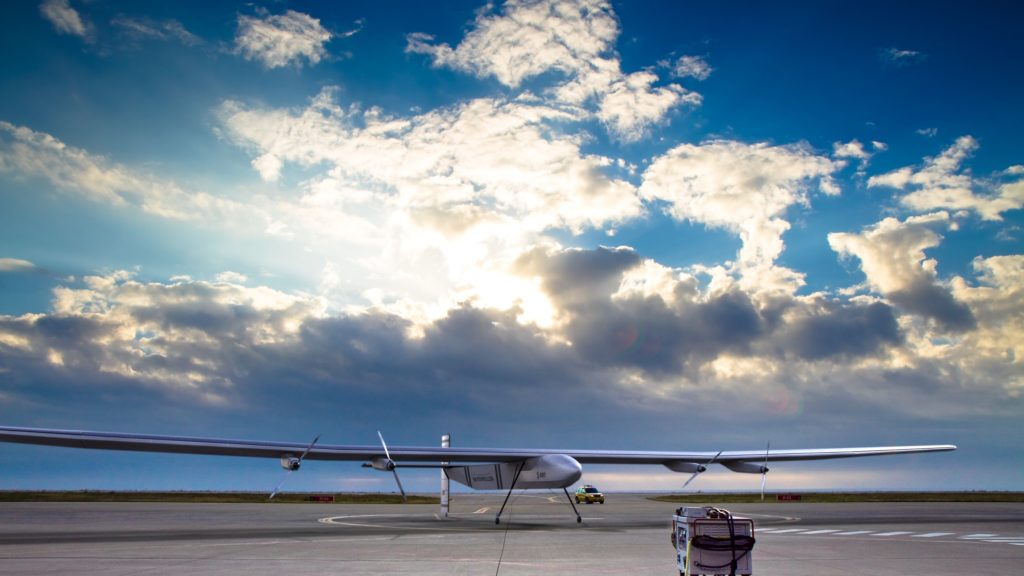
Skydweller Aero, a developer of ultra-persistent drones for commercial and military applications, has chosen Oklahoma City as its corporate headquarters, with plans to increase operations to 120 aerospace engineering and field technician jobs by 2024.
Founded by John Parkes and Robert Miller, Skydweller purchased the assets and intellectual property of the Swiss Solar Impulse project, which invested $190 million in developing experimental aircraft that in 2016 proved capable of circumnavigating the globe using only solar power.
Skydweller is in the process of converting the Solar Impulse design from a manned aircraft to an autonomous drone, capable of ‘dwelling’ over a location for months at a time without the need for refueling or maintenance work.
To accomplish this, Skydweller has a 72-meter wing span covered with 2,900 square feet of photovoltaic cells, which provide two kilowatts of power. Hydrogen fuel cells can be added for extra reliability, especially in poor weather conditions. Skydweller can cruise up to 100 knots and has an operational ceiling of 45,931 feet.
With 800 pounds of payload capacity, the drone can carry more radar and camera equipment than a MQ-1 Predator, whose primary role is reconnaissance and surveillance, though not as much as an MQ-9 Reaper, which often carries armaments as well.
“There are certainly differentiated missions that Skydweller can do that no other aircraft can do, but the core of it really is doing things that we do today better, smarter, cheaper, more effectively,” co-founder John Parkes told sister publication Avionics. “And that is communications — being a node in the sky whether for the military and first responder market or for the telecom world. And for the military specifically, doing intelligence, surveillance and reconnaissance (ISR) missions from an airborne perspective more effectively.”
The U.S. Air Force recently announced it is looking for a Reaper replacement — called “MQ-X” — to enter service around 2031. Though the Skydweller wouldn’t be able to fulfill all of the capabilities of the Reaper, as it isn’t designed to carry armaments, it could offer greatly reduced complexity and operating costs for ISR missions.
“Being able to fly thousands of miles, persist over an area for 30-60 days and fly back is a differentiator,” said Parkes. “It’s a huge cost savings to the U.S. government when you look at the whole cost of doing a lot of the national security missions that we have.”
In addition to reducing requirements for operating bases, Skydweller would require exponentially fewer takeoffs and landings than an MQ-1 or MQ-9, reducing the need for multiple platforms flying in a conveyer belt as well as associated maintenance costs.
“For us, if you’re flying 90 days with one aircraft, that’s two takeoffs and landings versus … hundreds,” Parkes said.
Outside of military applications, Skydweller’s medium-altitude, ultra-long endurance (MALE) drone could also provide cost-effective connectivity for remote populations. Though space-based connectivity solutions are improving, such as SpaceX’s low Earth orbit Starlink constellation, an aircraft at medium altitude will offer significantly more efficient use of spectrum than satellites more than 300 miles above the surface, Parkes said.
Though Parkes doesn’t expect the Federal Aviation Administration (FAA) or European Union Aviation Safety Agency (EASA) to finish their integration of unmanned aircraft into manned airspace any time soon, he believes governments will be interested in using Skydweller for communications applications to grant waivers. The aircraft is being designed to meet FAA Part 23 certification requirements.
Advancements in solar cells, batteries and other technologies driven by Tesla and SpaceX’s Elon Musk and numerous other players has rendered most of Skydweller’s development a “systems engineering exercise,” Parkes told Avionics — aside from its autonomy systems and ultra-redundant flight control systems, which comprised the bulk of the company’s engineering investment.
Skydweller raised $32 million in its Series A, including investment from Italian aerospace giant Leonardo, which owns about 17 percent of the company and controls one of seven board seats. Leonardo will also lead military relationships for the company in the United Kingdom, Poland, and Italy.